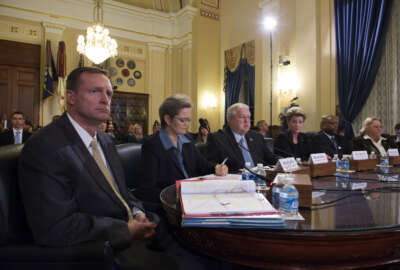
VA tired of waiting for IG disciplinary reviews, starts separate evaluations
The House Veterans Affairs Committee came down hard on the steps VA has taken so far to hold its employees accountable for misconduct. Deputy VA Secretary Sloan...
In search of a faster method to review and discipline its employees, the Veterans Affairs Department is conducting its own investigations of misconduct — separate from those of the agency’s Office of Inspector General.
The department also will put employees accused of misconduct on detail, rather than routinely placing them on paid administrative leave, VA Deputy Secretary Sloan Gibson told the House Veterans Affairs Committee Dec. 9.
Gibson, who attempted to explain his department’s recent efforts to hold its employees more accountable, said he shared the committee’s frustrations that disciplinary reviews were too time-consuming and too costly.
“We’ve waited too long, and we’re not going to do it again,” Gibson said. “I’m not going to defer to the IG’s investigation or frankly, to a Department of Justice investigation, because I can’t be assured when it’s going to be completed.”
Historically, the VA did not take the right actions against misconduct, Gibson said. That has led the department to go its own way from the IG’s efforts.
“That’s just me living and learning and growing up and understanding no, we’re just not going to do that anymore,” Gibson told reporters after the hearing. “We’re going to move ahead. We’re going to gather it and we want to work collaboratively with the IG. They’re great people and they do great work. But we’re just not going to wait forever.”
Gibson said the VA will consider the inspector general’s findings if they differ from the department’s, once the IG finishes its review.
The hearing, which often escalated to heated conversation, touched on a wide range of cases that have plagued the department over the past year, from whistleblower retaliation and appointment wait time manipulation, to the VA’s most recent relocation scandal.
Generally, the committee wanted to know why the department hasn’t fired, demoted or punished its employees more quickly.
“It gets tiring to constantly be told by you and other VA leaders that things are changing for the better and that you are committed to sustainable accountability, but then to witness otherwise,” said Rep. Jeff Miller (R-Fla.), the chairman of the committee.
The VA put 950 employees on probationary termination and removed 869 in fiscal 2015, according to Gibson’s testimony. An additional 423 employees resigned and 106 retired before the department could issue some kind of punishment.
“In all my years in the private sector, I’ve never encountered an organization where leadership was measured by how many you’ve fired,” Gibson said at the start of his testimony.
Following the wait time scandal at the troubled VA hospital in Phoenix, for example, the department placed two senior officials on paid administrative leave in May 2014. The VA hasn’t yet made a decision on disciplinary action for those employees.
Gibson said the VA now is reviewing tens of thousands of pages of documents and evidence that the IG submitted on the case within the past 30 days.
“We are wrapping up those two cases right now,” he said. “Both of those two employees were placed on administrative leave at the request of the IG.”
“The IG doesn’t make the decision,” said Rep. Tim Huelskamp (R-Kan.), during a heated discussion with Gibson. “You make the decision.”
For Gibson, launching reviews separate from the IG will ease Congress’ concerns that disciplinary decisions take too long.
In the case of the department’s relocation program, the department did make its own decision and Gibson stood by the department’s verdict to demote, rather than fire, the two senior executives at the center of recent accusations.
After looking at the IG’s report, Gibson said the VA found no evidence that the two employees violated any law or regulation when they assumed relocation benefits.
Again, he acknowledged the process took too long.
“We knew that there was an issue around the relocation expenses months before the IG released its report,” Gibson said. “But what did we do? We waited for the IG to go through the process. That’s not how we’re going to approach [this].”
Little relief to VA scheduling woes
Gibson also addressed another hot button issue. He predicted wait times for VA appointments won’t likely come down, as more veterans visit department facilities for care.
The Veterans Health Administration completed 56.2 million appointments between June 1, 2014 and May 31, 2015 — 2.5 million more appointments than the VHA finished during the same time period last year, according to Gibson’s testimony.
“As we improve access to care, as we improve care quality, as we improve the veterans’ experience at VA, I think we are going to find that demand will outstrip the ability to supply that care,” he said. “I would love to see wait times improve, but it’s a false promise.”
Gibson confirmed more than 512,000 veterans are waiting at least 30 days for an appointment, and more than 142,000 have been waiting more than 60 days.
The VA said it made progress on processing and scheduling appointments this fiscal year. In October 2015, the VA made 97 percent of its appointments in 30 days of the veteran’s preferred or clinically indicated date, according to Gibson’s testimony.
Yet some members took issue with discrepancies in the VA’s information on its own progress.
“You end up citing the very best data possible as it relates to wait times in your testimony,” said Rep. Julia Brownley (D-Calif.). “If you look at pending wait times and [other] data, it paints a different picture.”
Copyright © 2024 Federal News Network. All rights reserved. This website is not intended for users located within the European Economic Area.
Nicole Ogrysko is a reporter for Federal News Network focusing on the federal workforce and federal pay and benefits.
Follow @nogryskoWFED






